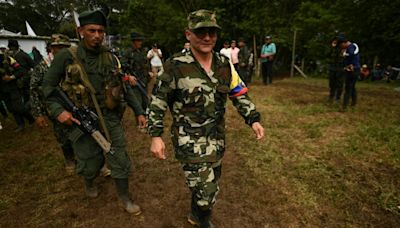Search Results
Colombia, officially the Republic of Colombia, is a country primarily located in South America with insular regions in North America. The Colombian mainland is bordered by the Caribbean Sea to the north, Venezuela to the east and northeast, Brazil to the southeast, Ecuador and Peru to the south and southwest, the Pacific Ocean to the west, and ...
- Overview
- Relief
Colombia, country of northwestern South America. Its 1,000 miles (1,600 km) of coast to the north are bathed by the waters of the Caribbean Sea, and its 800 miles (1,300 km) of coast to the west are washed by the Pacific Ocean. The country is bordered by Panama, which divides the two bodies of water, on the northwest, by Venezuela and Brazil on the east, and by Peru and Ecuador on the south. It is more than twice the size of France and includes the San Andrés y Providencia archipelago, located off the Nicaraguan coast in the Caribbean, some 400 miles (650 km) northwest of the Colombian mainland. The population is largely concentrated in the mountainous interior, where Bogotá, the national capital, is situated on a high plateau in the northern Andes Mountains.
The only American nation that is named for Christopher Columbus, the “discoverer” of the New World, Colombia presents a remarkable study in contrasts, in both its geography and its society. The lofty snow-tipped peaks of the country’s interior cordilleras tower high above equatorial forests and savannas where surviving indigenous groups still follow the lifeways and traditions of their ancestors. In the cooler mountains, at intermediate elevations, modern cities are juxtaposed with traditional rural landscapes where mestizo farmers cultivate their small plots of coffee, corn (maize), and other crops. The more accessible Atlantic lowlands, dominated by large livestock haciendas and a tri-ethnic population, have a distinctively different character.
Few countries boast such striking physical variety as does Colombia. Its broken, rugged topography, together with its location near the Equator, creates an extraordinary diversity of climates, vegetation, soils, and crops. The Andean cordillera, one of the world’s great mountain ranges, dominates the landscape of the western part of the country, where most of the people live. North of the border with Ecuador the cordillera flares out into three distinct parallel ranges. Two great river valleys, those of the Magdalena and the Cauca, separate them and provide avenues of penetration from the Atlantic coastal lowlands into the heart of the country. Volcanic activity in the geologic past blocked the middle course of the Cauca River to form a great lake that once filled the western inter-Andean trough for some 120 miles (190 km) south of Cartago. The river eventually broke through the dam to leave the level floor of the Cauca valley at some 3,000 feet (900 metres) above sea level; today it is one of the nation’s most productive agricultural areas.
Britannica Quiz
Guess the Country by Its Neighbors Quiz
The Colombian cordilleras belong to the northern portion of the great Andean mountain system, which extends along the Pacific coast of South America. The Andes are among the world’s most youthful mountain ranges and among the highest. The geologic history of this northern sector is less well understood than that of the central and southern parts. It is clear, however, that the entire cordillera has been thrust up through the subduction of the crumpled eastern margin of the Nazca Plate and, to the north, the Caribbean Plate under the more rigid but lighter South American Plate, which has been forced westward by the spreading Atlantic seafloor. These tectonic forces, similar to those found elsewhere around the Pacific Rim, continue to operate, as is evidenced by the high frequency of often destructive earthquakes. At the Pasto Massif, near the Ecuadoran border, the mountains divide into the Cordillera Occidental (“Western Range”), which runs parallel to the Pacific coast, and the Cordillera Central (“Central Range”), which, with its numerous volcanoes, forms the backbone of the system in Colombia and runs generally southwest to northeast. At the Great Colombian Massif of the Cordillera Central, near the San Agustín Archeological Park, the Cordillera Oriental (“Eastern Range”) branches off in a more decidedly northeasterly direction.
Of the three ranges, the nonvolcanic Cordillera Occidental, which forms the barrier between the Cauca valley and the rain-drenched Pacific coast, is the lowest and least populated. Two passes at elevations less than 5,000 feet (1,500 metres) between Cali and Buenaventura on the Pacific coast mark the lowest depressions in the range. Elsewhere the crest is much higher, reaching 12,992 feet (3,960 metres) at Mount Paramillo in the department of Antioquia. From there the Cordillera Occidental fingers north into the three distinct serranías of Abibe, San Jerónimo, and Ayapel, forested ranges that drop gradually toward the piedmont plains of the Caribbean littoral. A lesser topographic feature on the Pacific coast is the Baudó Mountains, separated from the Cordillera Occidental by the valley of the Atrato River, which empties into the Caribbean Gulf of Urabá; the Baudó Mountains represent a southward extension of the Isthmus of Panama.
Exclusive academic rate for students! Save 67% on Britannica Premium.
Explore Colombia's diverse attractions, from Andean summits and Caribbean coast to Amazon jungle and archaeological ruins. Find tips on the best time and places to visit, planning tools, and local expert advice.
- Cartagena. Best for architecture and atmosphere. At the top of most travelers' bucket lists for Colombia is the sultry city of Cartagena, and it's easy to see why.
- The Amazon jungle. Best for wildlife encounters. Colombia lays claim to an extraordinary glut of flora and fauna that should place it on any wildlife lover's must-see list.
- Zona Cafetera. Best for coffee lovers. If there's one thing that keeps Colombia running, it's coffee. Find out what all the fuss is about by exploring the Zona Cafetera, Colombia's coffee heartland.
- Parque Nacional Natural Tayrona. Best for combining nature and beaches. Home to palm-lined tropical beaches and secluded coves, Parque Nacional Natural Tayrona is one of Colombia's natural jewels.
Apr 10, 2024 · Colombia - The World Factbook. Explore All Countries. Colombia. South America. Page last updated: April 10, 2024. Photos of Colombia. view 4 photos. Introduction. Background. Colombia was one of the three countries that emerged after the dissolution of Gran Colombia in 1830 (the others are Ecuador and Venezuela).
Feb 3, 2024 · Discover the diverse and stunning destinations in Colombia, from coastal cities to rainforest wildlife. Learn from travel tips and recommendations by T+L A-list advisor Boris Seckovic and local hotel managers.



